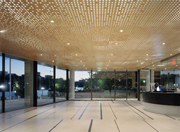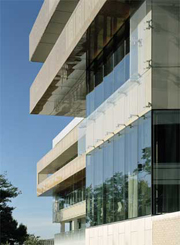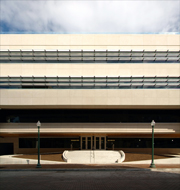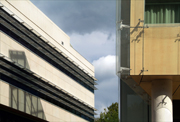Model Codes:
1996 BOCA Building Code with Local Amendments
1996 BOCA Fire Prevention Code
1993 BOCA Mechanical Code as Amended by City Council Bill 75-91
1993 NFIPA National Electrical Code as Amended by City Council Bill 75-91
1995 International Plumbing Code
1997 Americans with Disabilities Act
1993 BOCA National Energy Conservation Code
Architecture
House of Sweden inhabits one of the most perfect sites in Washington, D.C. Located at the intersection of Rock Creek and the Potomac River in scenic Georgetown, both buildings possess breathtaking views of the river, the Kennedy Center, and Watergate. Built on a single foundation, two separate towers rise out of the site, while sharing a below-grade parking garage.
The south building was designed by Wingardh Arkitektkontor AB and houses the Swedish Embassy along with an exhibit hall, convention center, rooftop terrance, and apartments. The architects designed this building to be “a shimmering jewel in the surrounding parkland.” To accomplish this goal, the base of the building is clad in light stone, while the upper floors are clad in glass laminated with a traditional Nordic blond wood pattern. This glass façade is backlit at night to create the illusion of the structure floating above the river. The south building has even been award Sweden's most prestigious architecture award; the Kasper Salin Prize for best building.
The north building houses offices and apartments, and incorporates expansive balconies and long stretches of ribbon windows to maximize exterior views. The façade employs the same type of light stone on the podium, but the upper floors are clad in metal panels. This lets the north building relate to the south building, yet keep its own identity.
Building Envelope
Both building envelopes are steel stud construction with faced blanket insulation and gypsum wallboard attached. The north building uses a standoff system to attach light stone panels to the podium of the building and metal paneling to the upper floors. The south building uses the same standoff system and light stone paneling on the lower level. The upper levels employ a different standoff system of laminated glass panels as cladding. None of these cladding systems are used as a barrier system, which is why the insulation is faced to prevent moisture penetration. The roofing is rigid insulation topped with ballast over monolithic EDPM waterproofing membrane on the north building. The south building uses the rigid insulation and ballast over monolithic EDPM waterproofing membrane around the perimeter and a concrete topping slab over the same monolithic EDPM waterproofing membrane for the roof terrace.
Construction
This project was a pretty standard project delivered with a design – bid – build method. Armada Hoffler was employed as the general contractor. The more interesting aspect lies with the developer, LANO Armada Harborside, LLC. This corporation was resulted as a joint venture between Armada Hoffler Developers and the SFV Property Board specifically to develop this project.
Structural System
The House of Sweden is located in Georgetown; therefore, the use of a post-tensioned concrete structural system was an obvious choice to help minimize the slab thickness. The foundation is cast-in-place piles that support a mat foundation that is a minimum of 38” thick, or 42” at the columns. The mat foundation rests on a 2” thick mud slab.
The north building has 6 levels above grade. The first floor slab is a 9”-10.5” thick reinforced two-way concrete slab with drop panels. The second through sixth floors are 7”-8” thick post-tensioned two-way concrete slabs with drop panels. The typical concrete strength is 6 ksi or 8 ksi. The concrete strength and slab thickness vary on each floor, which means that the slabs were not placed as single, monolithic pours and they had to be completed in sections. Because of the irregular building shape, there is no typical bay spacing, although many bays were kept at 30’ x 30’, possibly accounting for the change in slab strength and thickness.
The south building has 5 levels above grade. The first floor slab is a 9”-12” thick reinforced two-way concrete slab with drop panels. The second through fifth floors are 10”-12” thick post-tensioned two-way concrete slabs with drop panels. The typical concrete strength is 6 ksi or 8 ksi. The concrete strength and slab thickness vary on each floor, which means that the slabs were not placed as single, monolithic pours and they had to be completed in sections. Because of the irregular building shape, there is no typical bay spacing, although many bays were kept at 32’ x 22’, possibly accounting for the change in slab strength and thickness.
The columns in the two buildings are reinforced, normal-weight concrete. There is no typical column in either of these buildings. They use rectangular, square, circular, and circular notched columns. Some of the columns are custom shaped trapezoids. There are straight and sloped columns in the building and some of the columns get larger in size as the advance up the building. Typical column strengths are 6ksi from the garage to the third floors and 4 ksi from the third floors to the fifth floor in the south building and the sixth floor in the north building.
The north building lateral system uses shear walls from the garage to the fourth floor. These walls vary in size, they are 8 ” or 12” thick, 6 ksi concrete reinforced with #4 bars at 12” spacing in two curtains. The shear walls stop below the fifth floor where the structure becomes a concrete moment frame.
The south building lateral system has shears walls in the garage that are 12” thick, 6 ksi concrete with #4 bars at 12” spacing in two curtains. However, these walls do not extend past the garage level, and the building becomes a concrete moment frame.
Electrical System
The electrical power for the House of Sweden is supplied by PEPCO. The power supply enters on the 30th street side of the north building in two places through a transformer vault. The lines run through 2500A buses before being distributed to main panelboards. The main switchboard room is located at the level below the main lobby. It contains panelboards for both 120/208V and 277/480V feeds from the transformers. There are electrical rooms located on every floor of both buildings. Backup power is supplied by a standby generator and plans for a future generator exist.
Lighting System
To respond to the architect’s desire to have the buildings look like sparkling jewels floating above the landscape, the most unique lighting feature of the buildings is the backlit curtain wall on the south building. It is lit with what is considered recessed step lights, wall washers that present a soft indirect lighting effect to viewers. The corridors utilize cost effective 2’x2’ recessed fluorescent light fixtures. The north building lobby uses ceiling mounted 6” recessed downlights and the south building uses the same 2’x2’ recessed fluorescent light fixtures as the corridors, except that they are cover by hole-punched panels. All the lights in these public spaces are run on 277V so as to be energy efficient. The apartment and office areas have been outfitted to suit the tenants, and therefore, are not covered in this overview of the system.
Mechanical System
The House of Sweden’s mechanical system has a central plant on the penthouse level of the north building that contains water chillers and boilers. These units provide conditioning for all the air handling units in both buildings. The north building has two 100% outdoor AHUs and three AHUs. These are connected to variable air boxes so that each residential unit and the different commercial spaces can condition their spaces as they see fit. The south building has two 100% outdoor AHUs that connect to variable air boxes and provide air to the residential units and corridors. The embassy has its own separate AHU and mechanical room. The parking garage has three fan coils units to exhaust gases from the underground parking level.
Fire Protection System
Both buildings are fully sprinkled. The system is automatic with wet standpipes rising through the stair towers. Each side of the parking garage will employ an independent dry preaction fire protection system. The multi-story lobby of the south building has a 2-hour smoke rating, along with a 2-hour fire rating. The stair towers and elevator cores of both buildings have a 2-hour fire rating and the public corridors have a 1-hour fire rating. Areas of rescue assistance are also provided in the stair towers of both buildings.
Transportation System
Elevators:
The south building has two separate elevator areas located next to the stair towers. The main bank of elevators next to the main stairs has two electric traction elevators. These elevators are public and can be used to access all the floor levels from the parking garage to the penthouse level. The secondary electric traction elevator is located by the exterior stair tower. This elevator only has access to levels from the parking garage to the fifth level of the building. It is a more private elevator for tenants of the building to use. None of these elevators allowed a machine room at the top of the shaft due to the architecture of the glass enclosed stair tower and elevator core used as a feature.
The north building has a core of three electric traction elevators located in front of the main stair tower. These elevators extend from the parking garage to the sixth floor. They do not extend to the penthouse level due to the necessity of an elevator machine room located above the shaft.
Stairs:
The south building has two stair towers. The main stairs are accessed off the main lobby and run through the core of the building. This stair tower only extends from the second floor entrance level to the penthouse level. A secondary stair tower rises from the west exterior of the building and is encased in glass when it reaches grade. This stair tower runs from the parking garage to the penthouse level of the building. There is also a single open flight of stairs connecting the main lobby on the second floor to the first floor entrance level through an open air atrium space.
The north building also has two main stair towers. Both are located internally in the building and can be accessed from the parking garage and extending all the way to the penthouse level. They are initially involved in the same core as each other and the elevators, however, at the sixth floor, they separate into two separate cores.
Telecommunications System
This building is a high tech office and apartment space. Not only is the building provided with phone service, it has excellent in-house cellular coverage throughout the entire two buildings. The apartment spaces can also choose from a wide range of technology services including cable TV and high-speed internet access via a broadband cable network. Wi-Fi is also available throughout the apartment units and the commercial reception and conferencing spaces. Since the developer wanted to cater to business professionals, they also decided to offer a VoIP phone service. This service allows tenants to not only place a call with a land phone, they can also use a computer headset and microphone and all calls are communicated over a high-speed internet network. This improves clarity of a call and offers many services such as conference calling and voicemail that a professional will use everyday.
Special Systems
Due to the sensitive nature of this building, intrusion detection was a necessary part of the design. This protection includes, but is not limited to, intruder detection in interior protected areas through various means and intruder detection through the building envelope. It also covers surge protection to equipment, card key access to secure areas, and tamper protection on switches, controllers, annunciators, pull boxes, and other system components.







